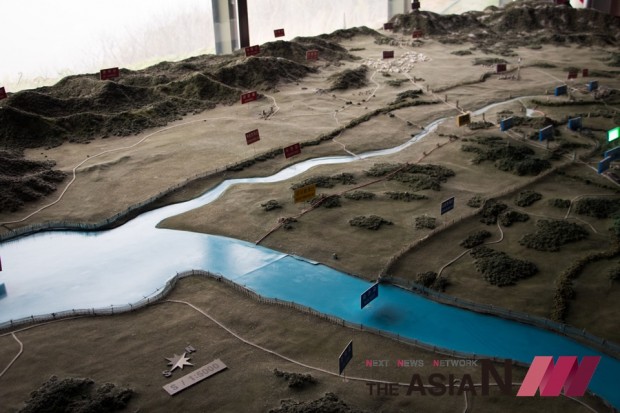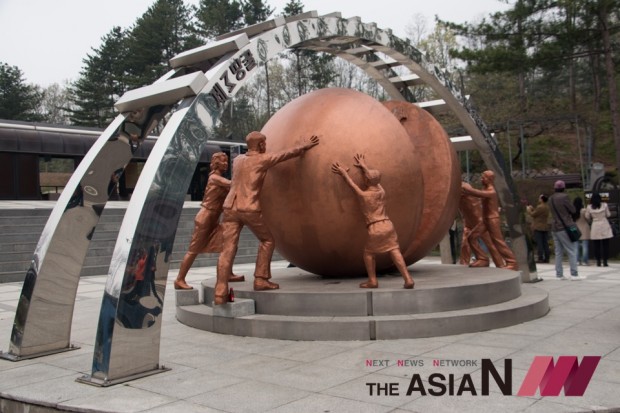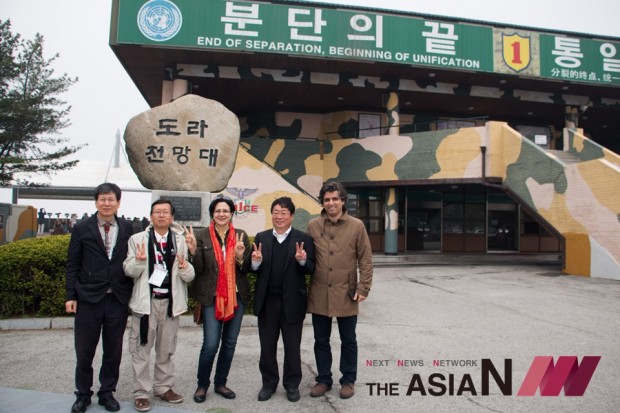
What! Not going down to ground zero at Panmunjong?
This was the sensitive spot where North and South Korean soldiers can be seen standing eye-ball to eye-ball, separated only by an imaginary line representing the 38th parallel that demarcates the two sides at the end of the Korean War (1950-1953).
Instead of a potentially tense tour, we were ushered to the touristic DMZ Observation Tower for a standard video show and army briefing. There, a US-ROK Command spokeswoman Jacqueline would not be drawn into telling us about the last-minute change of plan.
It seemed the presence of an international posse of journalists might prove a bit tricky, say, for crowd-control. Later, we were to learn that during our DMZ tour.
That Saturday, an enveloping mist had shrouded our view of the supposedly desolate no-man’s land that is re-awakening into a natural haven for rare Manchurian cranes. Still, we realised we were standing so close to the North, at a point where communist troops had poured across kindling the Korean War.
Kim Il-sung’s bid to re-unite the country by force was repulsed by United States and allied forces under the command of General Douglas MacArthur. His push towards Pyongyang prompted China to enter the war. A wider regional conflagration was obviated by a truce in 1953.
An uneasy peace prevailed over the decades even as the North cut tunnels to infiltrate commandos to the South. Several of these tunnels were huge enough for tens of thousands of troops to get through in an hour. We had the chance to stroll down the trail of one deep tunnel in the DMZ vicinity, underlining why South Korea could not afford to let their guard down.
Indeed, the serenity of a Korean Spring was once again shattered by North Korea’s nuclear and missile tests in January and February. This defiant act violated the United Nations ban on nuclear proliferation. Worst, it scuttled Pyongyang’s commitment in the Six-Party Talks Agreements to wind up its nuclear programme in return for economic and energy benefits.
South Korea and United States denounced the North’s provocations and pushed through tough UN sanctions and tightened the economic squeeze on Pyongyang. North Korea is vulnerable as it suffers from food and energy shortages. However, while in on the sanctions, China is concerned about its impact on the population and called for a return to multi-lateral negotiations.
Aggravating the tense atmosphere in April 2016, the North fired a submarine-based ballistic missile. It became clear later that the communist regime’s nuclear and missile tests were linked to the Korean Workers’ Party (KWP) Congress that took place the following week. The question is: why did Pyongyang chose to resort to sabre-rattling ahead of a crucial party congress?
Korea watchers believe the North’s new helmsman, Kim Jong-un, was keen to burnish his credentials as a worthy successor and defender of the realm against outside forces. The new nuclear and missile tests showed he was continuing the military-first (Songun) policy of his father Kim Jong-il. This certainly earned him spurs with the senior army ranks. At the same time, creating the crisis probably served his need to forestall any potential challenge to his supremacy.
Indeed, the KWP Congress proceeded to elect the 33-year-old Kim as party chairman, formally anointing the North’s new ruler. It is enlightening that post-Party Congress, Kim Jong-un began a charm offensive, offering to talk to US and South Korea.
South Korea President, Park Geun-hye, was not ready to parley. The daughter of former authoritarian president, Park Chung-hee, she was determined to see Pyongyang dismantle its nuclear facilities and disavow its hostile attitude towards Seoul.
North Korea has had a poor track record of keeping to their side of the bargain on de-nuclearisation and getting away with it. In 1994, when the DPRK was discovered to be developing nuclear bombs at its Yongbyong plant, the US had contemplated a surgical strike. However, Washington then embarked on high-level negotiation to defuse the crisis. Pyongyang was prevailed upon to disable its nuclear reactors in exchange for US security assurances as well as fuel and food assistance.
Unfortunately, North Korea was intent to gain a nuclear deterrence advantage against any regime-change style invasion by US. Kim Jong-il, who succeeded his father Kim Il-sung, carried out two nuclear tests in 2006 and 2009. This set the rigmarole of military provocations and brinkmanship and US-ROK-led condemnation backed by stiff sanctions.
The latest breach of the Six-Party Talks accord under Kim Jong-un has raised anew the poser: Could the unpredictable North Korean regime be trusted to do business with?
During our provincial tour, we had occasion to meet and talk to several up-and-coming South Koreans over dinner. I asked them how, as President, they would deal with the North’s Kim Jong-un. And do they know what he wants?
Governor Nam Kyung-pil of Gyeonggi Province, which is next door to North Korea, was all for opening up to the reclusive regime as a way of removing mutual suspicions. He thought that Kim Jong-un was concerned about preserving his dynasty. And once he is convinced that he would be left alone to rule the roost, he would be willing to talk. Mr Nam would like to see Seoul holding direct negotiations with Pyongyang, preferably without outside interference. “However, it could also take place within the framework of the Six-Party Talks,” he said. He would also want to see China and US leaning more on the North to abandon its nuclear ambitions.
Seoul City Mayor, Park Won-soon, is keen to engage Pyongyang economically and steer the regime in the direction of growth and development. Asked whether the ASEAN model, which brings together socialist and democratic states together, could apply to the Korean situation, Mayor Park said: “Regional forums for economic co-operation are there and North Korea has been approached to join them. It would be a good starting point. Pyongyang needs to build up confidence to work with neighbouring countries for peaceful growth in North-east Asia.”
Governor Nam and Mayor Park’s approach is reminiscent of the Sunshine Policy of President Kim Dae-jung and Roh Moo-hyun that brought about a period of détente between North and South.
President Kim and his Northern counterpart Kim Jong -il basked in the limelight of their summit meeting and there were family re-unions. But the euphoria generated by the South’s goodwill and economic gifts did not dissuade Pyongyang from its nuclear power ambitions.
Busan Metropolitan Mayor Suh Byung-soo has some qualms about engaging the North, where an hereditary dictatorship is opposed to the South’s elected presidency. He criticised the Kim dynastic rule for being self-serving and unable to care for the people’s welfare.
Kim Jong-un succeeded his father Kim Jong-il in 2011 and inherited a strong military but a shaky economy. Upon his election as chairman of the Korean Workers’ Party, Kim unveiled a five-year-plan.
Mayor Suh is sceptical that the repressive regime would survive for long if the economy worsens and people’s living standards continue to fall. Either Kim carries out reforms or his repressive regime would implode.
I mentioned to the mayor, that Confucian philosophy, which is held in high regard in South Korea, adjures rulers to govern in the people’s interest and welfare; otherwise, they would forfeit the Mandate of Heaven to stay in power.
It was noteworthy, that during our visit of Gyeongsangbuk Province, Governor Kim Kwan-yong made it a point to walk the foreign press corps through Byeongsan Seowan, a memorial center of Confucian studies ahead of lunch.
North Korea has been getting by with huge infusions of aid and other economic assistance from its chief ally, China. Its new young leader has the unenviable challenge of catching up with the economic power-house, South Korea.
Already, Seoul is moving beyond its current model of growth into creative and innovative technology. The Gyeonggi Center for Creative Economy and Innovation we visited, is preparing for the day when Korean mega-corporations become like “dinosaurs” losing their cutting edge. The CCIE centers would help small and medium start-ups launch their innovative products in the global market. The Samsung Innovation Museum is a veritable case of how from small beginnings, a home-grown electronic enterprise could make the leap to a world-class leader in mobile phone, smart TV and home appliances.
Why has North Korea lagged behind the South economically?
To be sure, Kim Jong-il had set out to realise his vision of a powerful military and prosperous economy. However, his so-called Moonshine Policy was hamstrung by its exploitation of Seoul’s capital and expertise in piece-meal joint ventures. Analysts noted that his reforms and restructuring of the economy have been stymied by the state’s isolation from the global economy. The lack of political will to go full steam ahead, they added, could stem from fear that fast-paced economic reforms would undermine the monolithic state’s control over the people and threaten his rule. Guided by the state ideology of ‘juche’ or self-reliance, Kim Jong-il was also said to be unwilling to embrace China-style reforms.
If the olive branch from Chairman Kim Jong- un, a Generation-Y man, is any hint, then change may be on the cards. Unlike his father, he may be more open-minded in trying out suitable economic success models. South Korea shines.
For two generations, first under Kim Il-sung and then Kim Jong-il, the North had been unable or unwilling to keep in step with the South economically, if not politically. Thus, the two sides have been diverging – instead of converging, in their economic and political systems – for a viable and peaceful formula to work towards reconciliation and re-unification.
After the excitement of DMZ, we experienced the serenity and solemnity of the United Nations Memorial Cemetery, the resting place of 2,300 UN soldiers who fought and died in the Korean War. The combat soldiers came from 16 countries and medical corps from five countries. After a ceremonial wreath-laying and moment of silence, we picked through the names engraved on the Wall of Remembrance and also walked through the Unknown Soldiers Pathway.
If we came detached to attend the Journalist Forum for World Peace, at the cemetery we were inspired by the soldiers who had fought and sacrificed their lives for sake of freedom and peace. We now see the Korean War in a new light as international in scope.
In signing the Declaration of Peace at the close of the Forum, we dedicate ourselves to spread the message internationally for a nuclear-free Korean Peninsula and for re-unification of the divided country.








